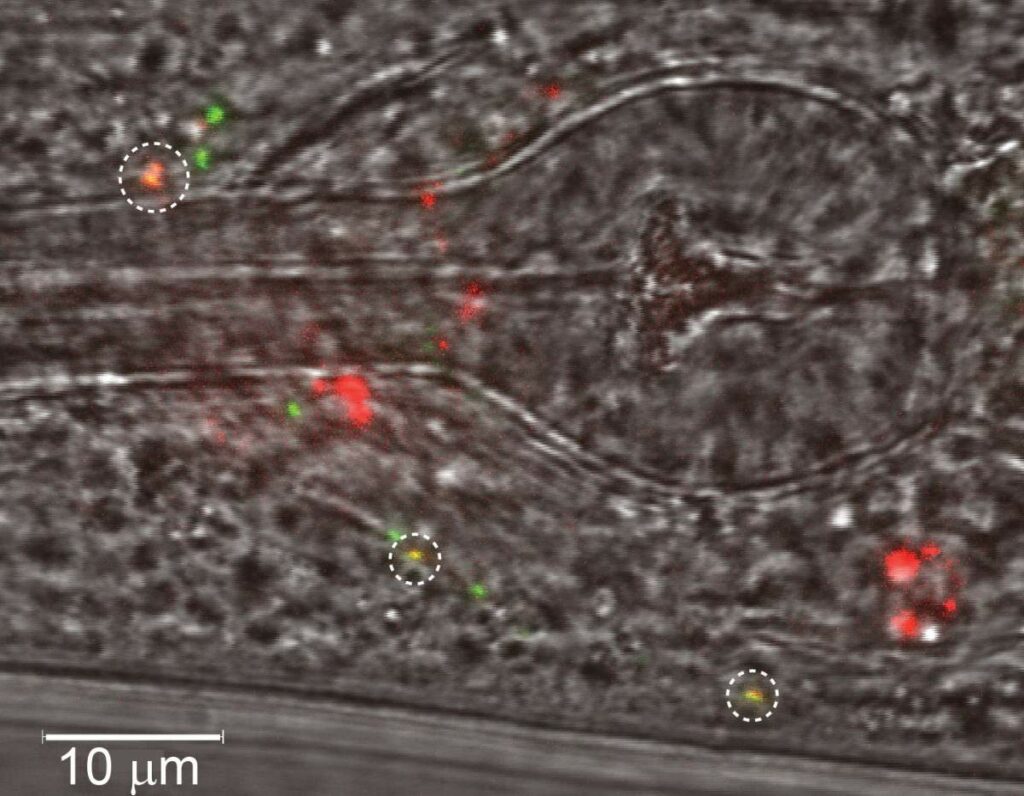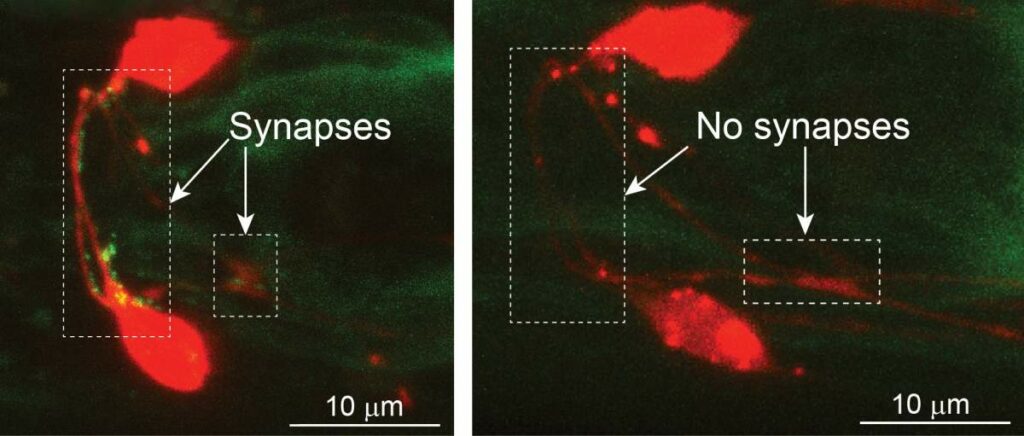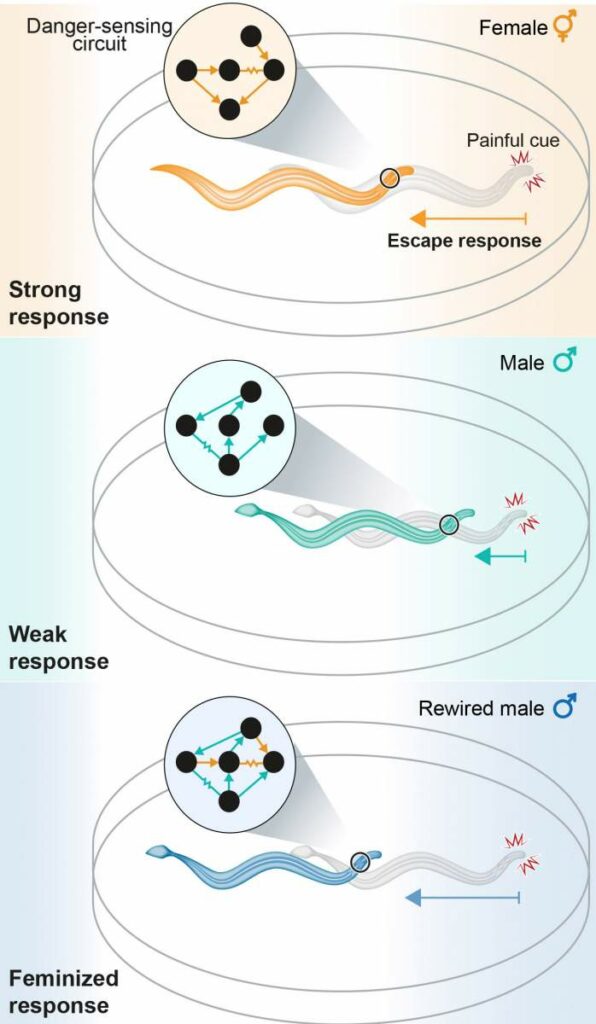
November 20, 2022
When a threat is looming and an escape route is open, one would expect any animal to flee imminent danger. But when microscopic worms faced a threatening signal in a lab at the Weizmann Institute of Science, only the females fled right away. The males stayed put until the signal grew much stronger. Puzzled at this difference between the sexes, the scientists used it to explore one of the greatest enigmas surrounding the brain: how the structure of its neural circuits shapes behaviour.
The transparent, one-millimetre-long worm, Caenorhabditis elegans, is uniquely suited for probing this question because it has a relatively broad repertoire of behaviours, and the wiring of its nervous system, consisting of only some 300 neurons, has been mapped for both sexes.
“We wanted to find out how the neural networks encode such different behaviours in females and males,” said Dr Meital Oren-Suissa, whose lab in Weizmann’s Brain Sciences Department studies sex-related differences in the brain and the rest of the nervous system, mainly using C. elegans as a model.
In experiments led by graduate student Vladyslava (Lada) Pechuk, the scientists found that worms exposed to harmful chemical substances sense the danger using receptors similar to those that convey the sensation of pain in humans, and the response of these receptors to the dangerous cue is similar in worms of both sexes.
The researchers also found that while the neural circuit that picks up the danger signal consists of the same neurons in females and males, the wiring of these neurons – that is, how they are connected to one another – differs in several ways between the sexes. The big unknown was which of these differences matter in terms of behaviour.
In response to a dangerous cue, the female (left) flees right away, whereas the male (right) stays put. The female is larger than the male, she is actually a hermaphrodite: Her reproductive organs produce both eggs and sperm
To address this question, Oren-Suissa teamed up with departmental colleague Professor Elad Schneidman, whose areas of study include the relations between the architecture of neural networks and their function.
Gal Goldman, a student under the joint supervision of Oren-Suissa and Schneidman, simulated the danger-sensing circuits of females and males, using mathematical models that she fitted to experimental data so that the simulations would recapitulate the recorded neural activity and the worms’ behavioural responses. Her model predicted that the differences in the wiring of the circuits in the two sexes would be sufficient to generate the different behaviours. She and the team then proceeded to the next challenge: determining which parts of the circuits are responsible for the behavioural difference. Moreover, they used the model to predict how changing the wiring might change the circuits’ function.
The model identified a critical difference in the wiring, which boiled down to a single connection, or synapse, between two neurons. These two neurons were connected to one another in the female, but not the male, worms.
“It’s widely assumed that the connections between neurons determine what a brain circuit can do, but it’s usually hard to test this experimentally in complex systems such as the mammalian brain,” Schneidman explained.
“The worm’s nervous system, in contrast, is small, relatively simple and experimentally accessible, so after making computational predictions about its wiring, we could ‘reprogram’ the circuit, thus putting our predictions to the test in a real animal.”
In a feat of molecular engineering, Pechuk and colleagues inserted the missing connection into the danger-sensing circuit of male worms, so that it would mimic that of females. As the model had predicted, the males equipped with the synthetic synapse started fleeing from the danger, just like the females.
“We managed to reprogram their behaviour just by altering a single connection in their neural circuitry,” Oren-Suissa said.
Why were the unaltered male worms so prone to risk-taking? The researchers believe that this may be due to the evolutionary force that Darwin termed ‘sexual selection’: the preservation of features that help the animal find mates at the cost of creating greater exposure to predators or other dangers – a peacock’s tail being one iconic example. In the case of C. elegans, the researchers hypothesized that if males possessed the ability to respond to danger or pain, they would be less competent in finding a mate.
“The male worm has to take risks – if he avoids all worrisome signals in his environment, he may never get to the female,” Oren-Suissa explained.
This is in contrast to the female, which is actually a hermaphrodite: Her reproductive organs produce both eggs and sperm, so she can be inseminated either by her own sperm or by that of a male.
This explanation was borne out by experiments. Whereas regular males rushed directly to the females – danger be damned – the engineered males with a synthetic synapse were much more hesitant, taking ten times longer to reach potential mates.
The study’s findings vividly illustrate the notion that altering synapses – which retain the same basic architecture from worms to humans – can lead to behavioural changes. Obviously, the human brain, with its trillions of synapses, compared to the worm’s 5,000, is vastly more complex than the nervous system of C. elegans
“Flipping one synapse in humans won’t change their behaviour – that would probably require rewiring on an entirely different scale,” Schneidman said.
But the study’s findings shed new light on the way the layout of neural circuits in the brain translates into behavioural tendencies and traits. In the future these findings may prove relevant to building artificial systems that mimic the entire human brain or its parts. The study also suggests a new direction for investigating why the two sexes in higher species, including humans, perceive pain differently.
Assistant Staff Scientist Dr Yehuda Salzberg from Oren-Suissa’s lab took part in the research. Also participating in the study were scientists from the State University of New York at Buffalo and from the University of Rochester.
In response to a dangerous cue, the female (left) flees right away, whereas the male (right) stays put. The female is larger than the male, she is actually a hermaphrodite: Her reproductive organs produce both eggs and sperm

(l-r) Professor. Elad Schneidman, Vladyslava (Lada) Pechuk, Dr Yehuda Salzberg, Gal Goldman and Dr Meital Oren-Suissa


Neurons (red) in the worm’s danger-sensing neural circuits. Fluorescent labeling reveals active neuronal connections (bright-green dots) that are present in females (left) but not in males

A drawing showing the danger-sensing neural circuit in female (top) and male (middle) worms. When a connection was added to make the circuit of males resemble that of females (bottom), the males responded to the dangerous cue similarly to females





